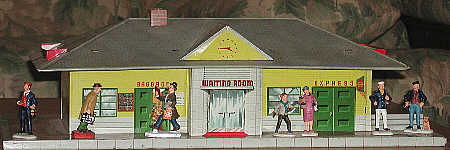
The station is scaled for smaller figures. To mitigate the size difference, we try to place people away from doors and other features that might highlight size. Figures are placed as far forward as possible, and none is directly standing in front of a green door. Note that when a platform is not crowded, waiting passengers stay apart. They stand alone or with the people with whom they know. Strangers keep a respectable distance.
The trainman stands at the end of the platform. He is a character figure who has a special place in this type situation.
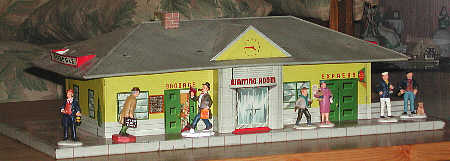
Seen from another angle. People are not positioned rearward on the sides, as this might call attention to the different scales of station and people. Figures are placed as close to the platform edge as possible, without looking out-of-place.
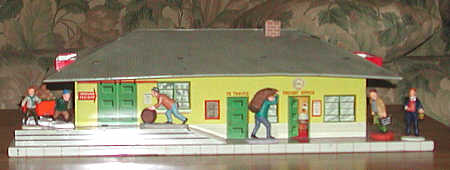
The back of the station is the freight area. Again, we do not silhouette figures in front of the doors. Placement is close to the platform's edge. The roof is too low on the left of the platform, and a normal figure's head would be much taller than the eaves. To mitigate this, we use figures who are stooping or bending, or shorter figures of the same scale. In this case, the barrel-roller is bent so far forward that he fits well. The short man with the red cart and the boy are shorter figures, and can be placed without calling attention to roof height. Once again, we place this trainman at the platform's corner, as he is looking for the train.

Another view - the man with the red cart is short and leaning forward, making him acceptable for placement on the left. The boy is naturally shorter than an adult-sized figure. Good placement makes for a busy and realistic scene, and manages to diminish any scale differences.
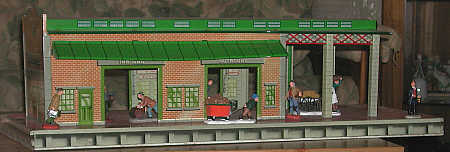
The freight platform's office door is too small, so we place figures away from them. The other figures give a feel of movement.

The man with the red cart looks as if he is pulling quickly, giving an idea of speed. He helps move the eye to the right. Other figures are not placed fully in the door. They are partially concealed by the walls, which is realistic. Again, as this is a railroad freight station ,the trainman takes a corner. The eye is naturally drawn toward him as it scans from left to right. Here he marks the right edge of a scene.
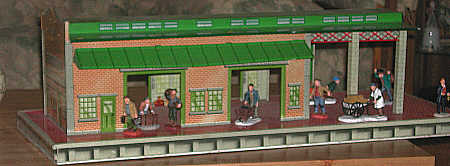
Figures moving to the left slow the rightward gaze, and help move the viewer's eye leftward. This scene does it slowly, using slower figures. Quick figures, such as the barrel roller, face the viewer. This way, their implied speed does not alter the viewer's gaze. Our quicker man with the red cart is inside.
Note how figures inside are partially silhouetted in the open bay doors. This allows them to be seen. Having them placed fully against a wall obscures them. Having them fully in the open bay makes them conspicuous. They are partially obscures, and this is more realistic. Figures can be in bay doors with affecting the illusion of scale. It is the office door on the left that must be handled differently. Small doorways help set our concept of a building's scale, since we know the average doorway is 6 1/2 to 7 feet high. To mitigate this, we must place figures so they do not highlight the difference in scale.